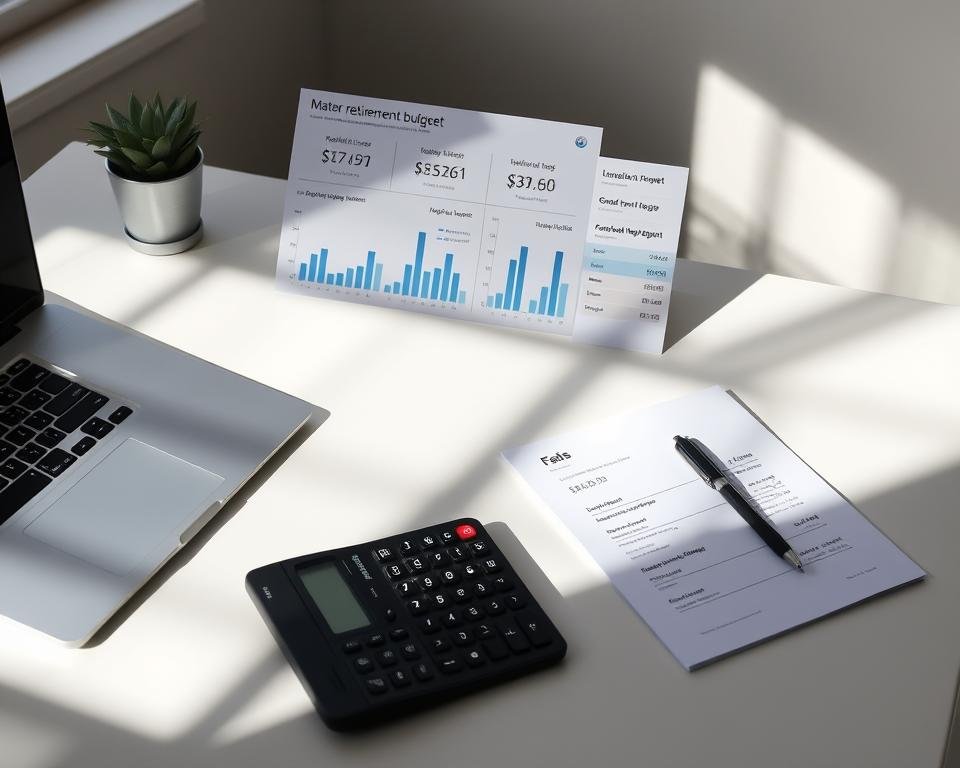Did you know over 60% of retirees live just on Social Security for retirement income? This fact shows how crucial it is to plan for retirement income. Creating a strong retirement budget with dividend income is key as you get closer to your golden years. This can make sure you have financial security.
When you invest in stocks that pay dividends, you get a regular income. This means you don’t have to sell your investments to cover everyday expenses. This approach reduces risks and helps you have a comfortable retirement.
Investing in companies known for regular dividend payments is smart. They offer a steady financial base.
This can make a big difference during retirement. A dividend strategy helps keep your finances in order and lets you enjoy life after work.
Key Takeaways
- Retirement budgeting is essential for financial security during retirement.
- Over 60% of retirees depend on Social Security as their primary income.
- Dividend-paying stocks can provide a steady income stream.
- Investing for retirement involves strategies to mitigate withdrawal risks.
- Consistent dividend payments enhance financial stability for retirees.
- A well-structured retirement budget can alleviate day-to-day financial stress.
Understanding Dividend Income and Its Benefits
Dividend income is key for a retiree’s budget plan. Retirees look to these payments from profits made by companies. Knowing how dividends work helps in creating a smart investing plan.
What are Dividends?
Dividends are money that companies give to their shareholders out of profits. There’s a set amount for preferred shareholders, while common shareholders get varying amounts based on the company’s success. These are usually paid quarterly, offering a regular income for those seeking passive income for retirement.
Types of Dividend-Paying Investments
There are many ways to invest for dividend income. While individual stocks come to mind first, ETFs that pay dividends offer big benefits. These ETFs focus on investing in reliable companies known for consistent dividends. This way, investors get a steady income and risk is spread out, which is vital for retirees.

Creating Your Retirement Budget
Making a detailed retirement budget is key for covering expenses and living comfortably later in life. It lays the groundwork for a smart retirement savings plan. This plan helps retirees manage must-have expenses like housing, healthcare, and food, while also looking at extra income options. Knowing both essential and extra costs allows for better use of dividend income to achieve financial independence.
Essential Expenses to Consider
Start your budget with critical expenses. These include:
- Housing costs (mortgage or rent)
- Healthcare and insurance premiums
- Utilities and maintenance costs
- Transportation expenses
- Groceries and everyday necessities
Knowing these monthly costs is crucial for your plan. It shows how much money you need from investments, like a retirement budget using dividend income.
Discretionary Spending in Retirement
It’s also vital to set aside money for fun expenses. These can greatly boost happiness and well-being. They include things like:
- Travel and vacations
- Hobbies and leisure activities
- Dining out and entertainment
- Gifts and special occasions
Having fun is key to a great retirement, so don’t skimp on discretionary spending. Mixing necessary expenses with fun ones leads to the most enjoyment of your funds. By making a careful budget that uses dividend income, you can aim for financial independence.

Calculating Your Dividend Income Needs
As you get closer to retirement, knowing your financial needs is key. It’s important to have a clear picture of your monthly bills. This helps you figure out how much money you should make from dividends. You need to estimate your expenses and pick a dividend yield that meets your goals.
Estimating Monthly Expenses
Start by adding up your needed monthly costs like housing and food. Also include healthcare and debts. This shows how much income your investments need to bring in. A detailed budget for fixed and changing costs gives you security. This helps as you manage your retirement money.
Determining Your Target Dividend Yield
For a steady retirement income, aim for a dividend yield between 3.5% and 4.5%. You find this yield by dividing your yearly money goal by your portfolio’s market value. For instance, for $75,000 yearly, you need about $1.87 million at a 4% yield. A smart dividend investment plan helps you make and grow this money. It’s vital to keep an eye on your investments. This way, you can spot risks like dividend cuts or falling stock prices early. Staying updated lets you tweak your plan when needed.
Strategies for Building a Dividend Portfolio
To build a strong dividend portfolio, focus on companies in good financial shape. They should have a history of increasing dividends. Look at things like dividend yield and growth rate. These show if a company can keep paying dividends.
Selecting High-Quality Dividend Stocks
For retirement, pick companies that have been consistent. You want ones with stable dividends and good earnings. Look for high-quality dividend stocks, including those called dividend aristocrats. They’ve raised dividends for many years, promising steady income and investment growth.
Diversification: Key to Reducing Risk
Spreading investments across 20 to 60 stocks in different sectors lowers risk. It’s smart to include utilities, consumer goods, and healthcare. This way, you’re not too affected by troubles in one area. Keep researching and checking your stocks for the best results in retirement.

Monitoring and Adjusting Your Dividend Income
To stay financially independent during retirement, you must watch your dividend income closely. It’s important to check how your investments are doing regularly. This helps ensure they meet your retirement budget needs. By keeping an eye on your investment’s performance, you can see which ones might need a tweak. This way, you can adjust them to better meet your financial goals.
Tracking Your Investment Performance
Checking how your dividend investments are doing regularly is key to getting the most out of them. Here are things investors should look at:
- Consistency and growth of dividend payments
- Financial stability of the companies issuing dividends
- Overall yield of the dividend portfolio
Keeping a close watch helps you make smart moves about assets that aren’t doing well. By staying proactive with your portfolio, you improve your chances for a better financial future. It’s important to make sure your investments are in line with your income goals. For tips on creating a strong dividend strategy, click here.
Adapting to Changes in Expenses or Income
Changes in life can affect your retirement budget. When your expenses or income change, adjusting your investments is vital. Being able to change your plan helps you manage these shifts. Look at how you’re spending money and maybe change how you’re investing to get more from dividends. This flexibility is crucial for keeping up with your financial goals during retirement.

Keep reevaluating your financial situation to protect or boost your financial independence. Taking an active role in managing your investments helps your portfolio grow with you. It also keeps up with the changing market.
Tips for Maximizing Your Retirement Income
To boost your retirement funds, think about reinvesting dividends. This move helps grow your investment and future income. Letting dividends pile up means more money down the road. Companies that consistently increase dividends add value to your portfolio and income.
Looking into extra income sources is also wise. Earning from a part-time job, annuities, or rentals can spread out your financial risk. These extra sources can make your retirement more enjoyable. For tips on managing your retirement money, check out maximizing pension income.
Retirement investing shouldn’t rely on just one type of income. A strong plan includes different assets. Mixing dividend investments with other sources can ensure a stable future. These steps can lead to a secure and happy retirement.
